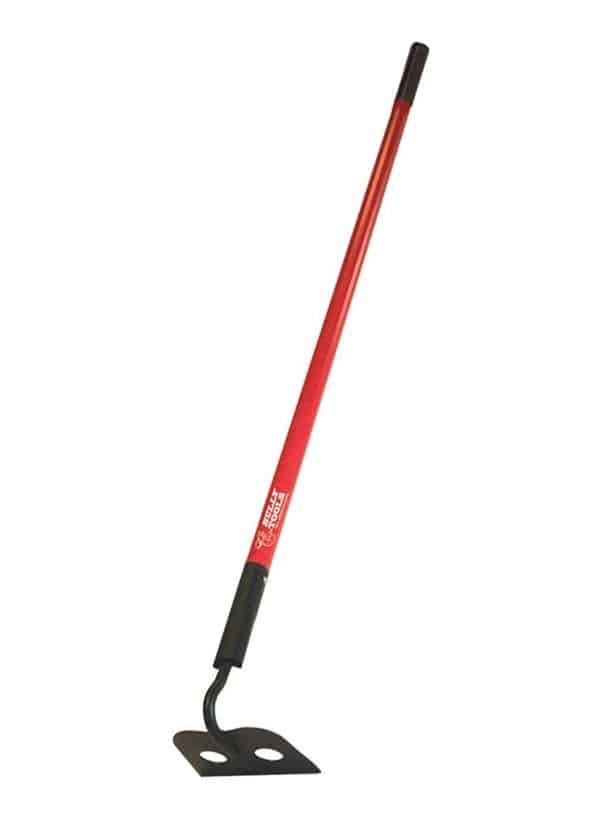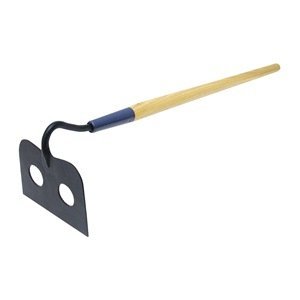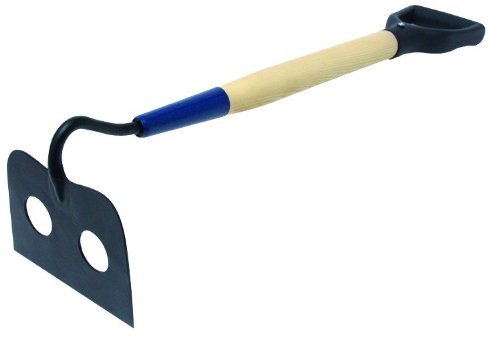The 5 Best Mortar Hoes Available Online & Why They Are at the Top of Their Field

Best mortar hoe - Worker using hoe for mixing cement power with sand
Quick Navigation
HAVE YOU TRIED TO MIX a large batch or mortar using a shovel, regular garden hoe or even a trowel? Pretty tough, isn't it? A good mortar hoe will make the job much easier and significantly reduce the strain on your body.
Although they are quite a niche product, mortar hoes will help with cement, and concrete. You can also mix through fertilizer through soil to create that perfect potting mix.
Just like any other tool in the garden shed, having the right mortar hoe can make all the difference in the world. And I especially recommend them for people with bad backs as mortar hoes eliminate most of the bending over in the mixing process.
There Are Only Three Things You Need to Consider
The mortar hoe is not much different from a garden hoe in that it has no moving parts and if you buy the right one, will provide you with many years of service. These parts are the handle, the hoe blade, and the way in which the head is mounted to the handle.
The Head or Blade
Much like the standard garden hoe, the head or blade of the mortar hoe is the most important piece of the puzzle. A blade made from the wrong materials or that is improperly designed will not take away from your workload. Instead, it may actually add to the workload and make mixing a spreading mortar that much harder.
The blade should:
- Be the right size for the job
- Be made from top-quality steel
- Have holes in it to allow the mortar to pass through for better mixing
- Be strong enough not to bend while being used
- Will not rust over a short period of time
The Mortar Hoe Handle
Mortar hoe handles come in a wide range of lengths from 24 inches long to 66 inches long and more. When choosing a mortar hoe, be sure the handle you choose is long enough for the job you have in mind and that it feels good in your hands and is not likely to cause a problem if you have to use your hoe for a long time.
Handles are made from aluminum, fiberglass, and aluminum, each of which has their advantages and disadvantages. For example, wood may flex a little but can stand up to a lot of flex before breaking. Fiberglass is very lightweight, but it is more flexible and may shatter under a heavy load. Aluminum is lightweight and flexible but may bend when being used for heavy work.
Handles also come in straight and "D" handle designs, both of which work well. Your decision should be based on which of these designs work best for you and the job you have in mind.
Bear in mind that mortar hoes can be used for a wide range of projects beyond simply mixing and smoothing out mortar. You can use this type of hoe to mix concrete, mix things like sphagnum peat moss into your soil, mixing sand into your soil, or even mixing small rocks and gravel together and spreading them out.
Features to look for in a mortar hoe handle:
- Flexibility to absorb the shock of being used without breaking
- The right length for the job you have in mind
- Be properly finished to protect it from the elements
- Be properly fastened to the head of the hoe
One of the biggest issues with mortar hoes is the possibility of the head pulling away from the handle, which makes it really hard to mix or spread the mortar (trust me there is nothing worse than having to retrieve the head of your hoe from the middle of a freshly mixed batch of whatever you're mixing). Look for hoes with heads that are riveted or bolted in place.
Heads also come in various widths and heights based on the type of work they are designed to do, all the way up to those with heads over 12 inches wide for smoothing out large areas of work. In fact, you might find that you need several different mortar hoes to get everything you need to get the job at hand done right.
While most mortar hoes come with steel heads, not all heads are created the same. Some are much thicker than others. Beware of heads made from thin gauge steel as they are likely to bend and break, whereas those made from thicker steel will hold up to heavy work more effectively and are less likely to rust or fall apart.
With all of this in mind, let's take a look at 5 of the top mortar hoes for you to consider in your search for the right one for the job you have in mind.
My Picks for Top 5 Mortar Hoes
1. Bully Tools 92360 12-Gauge Mason Hoe with Fiberglass Handle
Top-quality American made mortar hoe with a triple-wall fiberglass handle
Not only does this mortar hoe come with an extra-thick 12-gauge head, it also features a triple-wall fiberglass handle for added durability. The fiberglass handle is reinforced with 14-gauge steel, it also features an extended length ferrule beam supports to help keep the head firmly fixed in place. The two large holes make using this hoe to mix mortar or cement far easier than if you were to use a shovel or standard garden hoe.
Pros | Cons |
|---|---|
24-gauge steel head | A single rivet holds the head in place |
14-gauge steel extended length ferrules | Steel-reinforced fiberglass handle heavy |
Rubber grip at top of handle |
2. Marshalltown – The Premier Line 14279 6-Inch by 10-Inch Mortar Hoe with 66-Inch Hardwood Handle
Natural hardwood handle and carbon steel head for added durability
This mortar hoe features a 66-inch long natural hardwood handle that has just enough flexibility to take some of the strain out of mixing. The head is formed from a single piece of forged carbon steel for added durability. Two large holes in the blade make mixing mortar, cement, and concrete easier. The steel ferrule is riveted to head to keep it solidly in place. This is a contractor grade tool that definitely lives up to its reputation.
Pros | Cons |
|---|---|
Carbon-steel head | Single rivet in ferrule may fail under load |
Hardwood handle | Sharp corners leave mix in wheelbarrow |
Perforated blade for easy mixing | Heavy |
3. Kobalt 54-in Wood-Handle Mortar Hoe
Solid ash handle from the forests of North America
This tough as nails mortar hoe features a 1-piece forged steel head for superior strength and maximum durability. The 54-inch long North American ash hardwood handle has just the right amount of flex to be comfortable while you work. Like all good mortar hoes, the dual perforated holes are perfectly placed to make mixing your mortar or cement easier. The handle and head are pinned together to ensure the head stays in place.
Pros | Cons |
|---|---|
1-piece forged head | Handle may be short for taller people |
Solid ash handle | Wood handle may split if left out in rain |
Handle and head pinned together |
4. Kraft Tool BC229 61/2-inch by 43/4-inch Short Mortar Hoe with a 21-inch Wood Handle
Short and sweet – perfect for those smaller tasks
They say good things often come in small packages, and this mortar hoe is a good example of this old saying. The 21-inch hardwood handle is perfect for working in smaller areas where precision is needed. Like full-size hoes, this one features dual holes for ease of mixing. The long tang and steel ferrule are designed to help keep the head firmly fixed in place. It is perfect for mixing mortar or cement in wheelbarrow thanks to the shorter handle.
Pros | Cons |
|---|---|
Strong steel blade | Not for big jobs |
Hardwood handle | Head is not riveted or bolted to the handle |
Long tang and steel ferrule |
5. Marshalltown – The Premier Line 14281 D-Handle Heavy Duty Mortar Hoe
Short and Sturdy Gets It Done
For those who need a little more control, this D-handle mortar hoe might be just what you need. The 18-inch hardwood handle with a sturdy D-shaped handle lets you take more control when mixing and finishing. The head is forged from a single piece of carbon steel and is held in the steel ferrule with rivets for added strength and durability. The black powder finish will help protect the metal from corrosion.
Pros | Cons |
|---|---|
18-inch hardwood handle with D grip | Rivets may come loose |
Holes for easy mixing | Paint may not protect from corrosion |
D-grip offers better control |
Other Options
Bucket Mortar Mixer
Power mortar mixing at its best
When all you need is to mix up a bucket of mortar this tool and a strong 1/2-inch chuck drill will whip up a 5-gallon bucket of mortar in a hurry. The corkscrew lifts the dry mortar up from the bottom of the bucket to the top for a smoother and faster blend. The foam-covered handle features oiled bearings for smoother operation.
Pros | Cons |
|---|---|
Power mixing = less hard work | You must have a 1/2″ chuck electric drill |
Mix four gallons of dry pack in 30 seconds | Can be hard to handle at first |
Oil-impregnated bronze bearings in handle | Can only mix four gallons at a time |
The Final Mix
For my money (since that's all I have to spend), the Bully Tools 92360 - check its product page - is the clear winner. While it is a little on the heavy side, but I didn't mind the extra weight since I didn't have to worry about it breaking or bending. I also love the heavy-duty steel blade that doesn't give when I am mixing a wheelbarrow full of fresh cement. This mortar hoe meets all the needs I listed up above. It has a strong blade, a strong handle, and is made to last. I have one of these in my shed along with the Bucket Mortar Mixer for the small jobs.
I hope that the information above has taught you something about what to look for when you go out shopping for the best mortar hoe. Find one that meets everything above and feels good in your hands and you have a winner.
If you plan on starting a project or garden, make sure you have the right tool for the job as it would make it easier.
If you liked what I have put together for you here, please let me know.
Let everyone know you enjoyed reading this on Facebook and Pinterest.
Thank you for reading this.
Related Articles:







